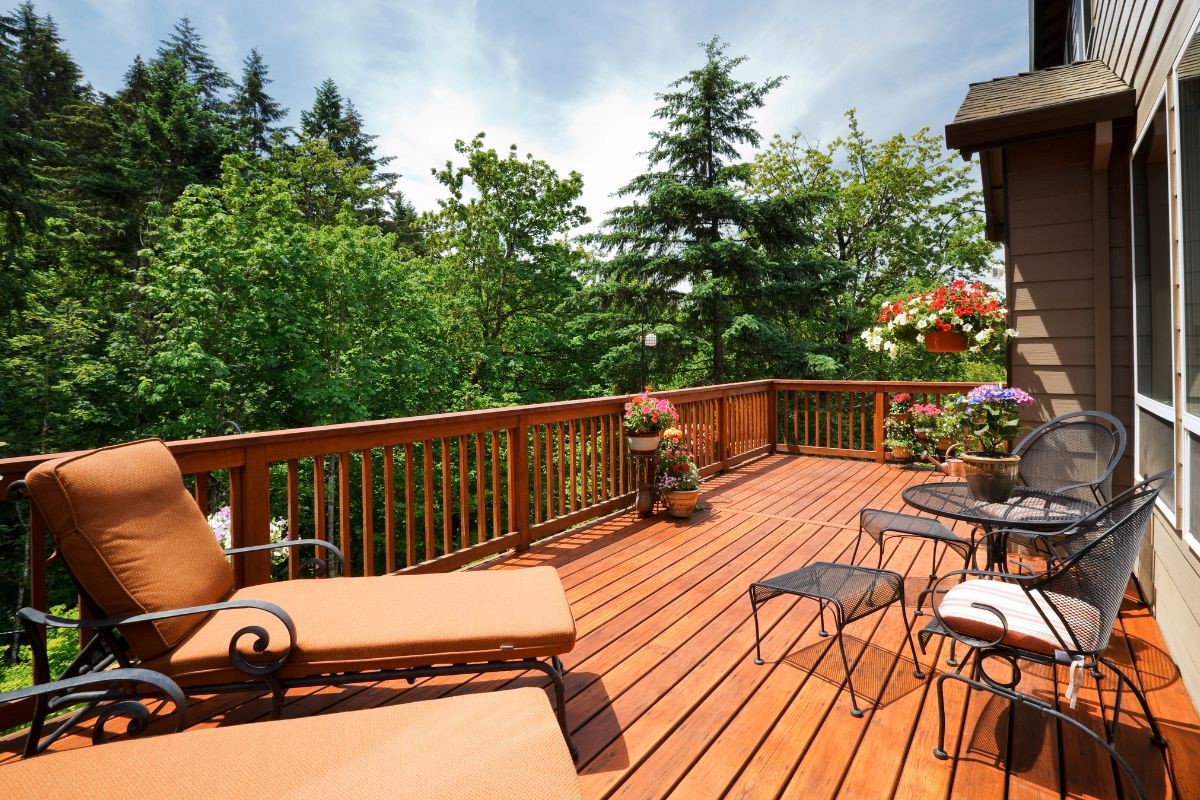Nestled beneath the boundless canvas of the sky, architecture takes on dreamlike forms—It’s a world where imagination marries functionality, where spaces come alive with character. In this realm of creative expression, a silent hero waits to emerge – grey composite decking. Dive into the world of architectural wonders, where this innovative material, a fusion of wood and plastic, paints stories of versatile design possibilities.

Design Versatility
1: Evolution of Decking Materials
Traditional Wood Decking: A Thing of the Past
Tradition often collides with modern demands in architecture. For generations, wood decking reigned supreme, lending rustic charm to outdoor spaces. However, it’s time to bid adieu to this age-old material. While undeniably beautiful, traditional wood decking demands constant maintenance. Yearly staining, sealing, and repairs transform a serene retreat into a taxing chore. With a global focus on sustainability and eco-conscious living, wood decking’s impact on forests and land usage raises concerns.
Rise of Composite Decking: A Sustainable Solution
Composite decking, composed of wood fibers and recycled plastic, redefines outdoor aesthetics. It’s a low-maintenance alternative that refuses to compromise on beauty. Unlike wood, composite decking requires no annual upkeep, enduring harsh elements without warping or splintering. By recycling plastic and utilizing wood fibers, composite decking reduces its ecological footprint. As we delve further into architecture, you’ll discover how this innovative material transforms outdoor spaces sustainably.
2: Understanding Composite Decking
Composite Decking Composition
As we unravel the intricate world of composite decking, it’s imperative to understand its composition. This composite material is a blend of wood fibers and recycled plastic. The fusion of these two seemingly diverse components creates a synergy that’s both aesthetically pleasing and incredibly robust.
The wood fibers lend a warm, natural appearance, while the recycled plastic provides strength and durability—the resulting composite material possesses a unique ability to mimic the look and feel of real wood without the shortcomings of its natural counterpart.
Benefits of Composite Decking
Composite decking doesn’t just look the part; it boasts a wide array of benefits. Its low-maintenance nature makes it an ideal choice for those who want an outdoor space without the constant upkeep. Unlike traditional wood, composite decking doesn’t require annual staining, sealing, or repairs. It resists the harshest weather conditions, standing firm against sun, rain, and snow without warping or splintering.
Another compelling advantage is the eco-friendliness of composite decking. By repurposing plastic and using wood fibers, it significantly reduces the impact on natural forests. This sustainable approach aligns with the growing global emphasis on environmentally responsible construction.
3: The Creative Canvas
Color Variations and Textures
Unleash your creativity with composite decking’s myriad color options and textures. Whether you prefer the warm, earthy tones of wood or the sleek, modern feel of stone, composite decking offers a range of possibilities. From deep browns to vibrant reds and even cool grays, your outdoor space can mirror your vision—the textures available range from classic wood grain to a smooth, contemporary finish. Your design canvas is as diverse as your imagination.
Mimicking Natural Materials
Composite decking is a master of disguise, skillfully replicating the charm of natural materials. From the rich grains of timber to the rugged elegance of slate, composite decking can mirror the look and feel of various elements, enhancing your outdoor space’s aesthetics. It brings nature’s beauty to life in a form that doesn’t fade, warp, or crack.
Customization Possibilities
The beauty of composite decking lies in its ability to cater to your unique design aspirations; it’s not just about colors and textures; it’s about customizing every detail. Whether you envision intricate patterns, innovative shapes, or specific dimensions, composite decking can make it happen. Your outdoor space becomes a reflection of your creativity, with endless possibilities for personalization.
4: Durability and Longevity
Resisting the Elements
Composite decking stands strong in the face of nature’s elements. Unlike traditional wood, it doesn’t yield to the relentless sun, heavy rain, or icy snow. The composition of wood fibers and recycled plastic creates a material that’s inherently resistant to weather-induced damage. It won’t warp, crack, or splinter, maintaining its pristine appearance even after years of exposure. This durability ensures your outdoor space retains its beauty through the harshest conditions.
Minimal Maintenance
Bid farewell to the laborious maintenance routine that often plagues wood decking. With composite decking, there’s no need for annual staining, sealing, or arduous repairs. A simple periodic cleaning is all it takes to keep your outdoor space looking its best. The low-maintenance nature of composite decking liberates you to enjoy your space without the constant worry of upkeep.
Warranty Assurance
Composite decking manufacturers understand the trust you place in their products. That’s why many offer robust warranties, giving you peace of mind. These warranties often cover everything from material defects to performance guarantees; it’s a testament to the confidence in the durability and longevity of composite decking. The assurance of warranty protects your investment and ensures your outdoor space remains a source of joy for years to come.
5: Eco-Friendly Building with Composite Decking
Sustainability Features
Composite decking emerges as a beacon of sustainability in the realm of architectural choices. Its unique composition, featuring wood fibers and recycled plastic, embodies eco-conscious design. By repurposing discarded plastic and integrating wood fibers responsibly, composite decking significant curtails its environmental impact.
This environmental stewardship extends beyond raw materials, unlike traditional wood decking, composite decking boasts a long life cycle, reducing the need for replacements and the associated depletion of natural resources. With an eye on sustainability, it’s a choice that aligns with contemporary eco-friendly construction practices.
Reducing Environmental Footprint
Composite decking is more than just an eco-friendly option; it actively contributes to reducing the environmental footprint of outdoor spaces. The low-maintenance nature of composite decking translates into fewer chemicals and less energy consumed—It’s a choice that not only preserves the charm of your outdoor area but also fosters a greener tomorrow. By selecting composite decking, you are not only making a design statement; you are taking a step towards a more sustainable world.
6: Composite Decking in Residential Architecture
Expanding Outdoor Living Spaces
Composite decking is a transformative addition to residential architecture, expanding outdoor living spaces in ways previously unattainable. The flexibility of this material allows for the creation of inviting ducks, patios, and lounging areas that seamlessly blend with your indoor living areas. Your backyard becomes an extension of your home, offering the perfect setting for outdoor dining, relaxation, and entertainment.
Blending with Natural Surroundings
Incorporating composite decking into residential architecture harmoniously blends your outdoor oasis with its natural surroundings. The material’s versatility allows for designs that complement the landscape, whether you’re nestled in a forested retreat or overlooking an urban skyline. It’s a design choice that nurtures a sense of unity with nature while providing the comforts of modern living.
Safety and Comfort
Safety and comfort are paramount in residential architecture. Composite decking excels in both these aspects. It’s slip-resistant surface ensures secure footing, reducing the risk of accidents. Additionally, composite decking remains comfortable underfoot even during scorching summers, eliminating the need for shoes and allowing you to fully enjoy your outdoor haven.
7: Commercial and Public Applications
Composite Decking in Public Parks
Composite decking extends its reach beyond residential architecture, finding a well-deserved place in public parks. Its durability and low-maintenance characteristics make it a wise choice for park boardwalks, picnic areas, and observation ducks. The public can revel in the beauty of nature without the distractions of maintenance.
Decking in Commercial Establishments
Restaurants, hotels, and commercial establishments have recognized the allure of composite decking. Its aesthetic charm and resistance to wear and tear make it an ideal choice for outdoor dining areas, rooftop bars, and lounges. This material transforms commercial spaces into inviting havens that attract patrons while keeping maintenance costs at bay.
ADA Compliance
In an era of inclusivity, composite decking adheres to ADA (Americans with Disabilities Act) compliance, ensuring access for all. Ramps, walkways, and platforms constructed with composite decking make public spaces welcoming to individuals with disabilities. It’s an essential aspect of modern architecture that encourages inclusiveness and accessibility for everyone.
8: Overcoming Design Challenges
Navigating Slopes and Elevation Changes
Architects often face the challenge of uneven terrain, but composite decking offers a solution that gracefully navigates slopes and elevation changes—Its flexibility and ease of installation enable architects to craft smooth transitions, ensuring that your outdoor space remains accessible and visually appealing.
Creating Unique Shapes and Patterns
Composite decking opens the door to limitless design possibilities. Whether you envision curved ducks, intricate patterns, or unconventional shapes, this material is your creative canvas. It’s a versatile tool that allows architects to bring your unique design visions to life, ensuring your outdoor space stands out in style.
Integration with Landscaping
One of the key design challenges in architecture is seamlessly integrating outdoor spaces with landscaping. Composite decking is the bridge that connects your architecture with nature. Its customizable nature enables architects to design decking that flows harmoniously with the surrounding greenery. It’s a vital tool for architects who aim to create spaces that feel one with the environment.
9: Maintenance and Care Tips
Cleaning and Stain Removal
Maintaining the beauty of composite decking is straightforward. Regular cleaning, using gentle detergents and a soft brush, keeps your decking looking pristine. In the event of stains, timely action is crucial. Most stains can be removed with mild cleaners and a bit of elbow grease. It’s a minimal effort that keeps your outdoor space looking its best.
Protecting against Fading
To preserve the vibrant colors of your composite decking, protecting against fading is essential. The sun’s rays, while harmless to your skin, can impact the color over time. To safeguard against fading, using specialized composite deck cleaners and UV protectants is advisable. These simple steps ensure your decking retains its original allure.
Repairing Damages
Even durable composite decking can face wear and tear. Minor damages such as scratches or gouges can be repaired with a composite deck repair kit. For more severe issues, consulting a professional is recommended. Timely repairs keep your decking looking pristine and extend its lifespan.
10: Cost Considerations
Upfront Costs vs. Long-Term Savings
When contemplating the choice of decking material, it’s essential to weigh the upfront costs against the long-term savings. While composite decking may have a slightly higher initial investment than traditional wood, its cost-efficiency over time becomes evident. The minimal maintenance requirements, long lifespan, and durability translate into substantial long-term savings making it an intelligent investment in your architectural project.
Return on Investment
Architectural decisions should always consider the return on investment. Composite decking offers an impressive ROI. It appeals to potential buyers and the longevity of the material contribute to the increased value of your property. Whether you’re building your dream home or improving an existing one, the choice of composite decking is an investment that pays dividends.
11: Case Studies
Coastal Retreat: A Composite Decking Masterpiece
Imagine a coastal retreat where azure waves meet a pristine shore, and architectural elegance meets nature’s fury. In this coastal masterpiece, composite decking takes center stage. Here, a stunning composite deck does more than offer a place to rest; it weaves a story of resilience and beauty.
Salt-laden air, relentless sun, and the sea’s relentless spray – these are the challenges of a coastal setting, traditional wood would succumb but not composite decking. It stands firm, harmonizing with the seascape, resisting the corrosive effects of salt, and remaining unblemished by the elements.
This case study showcases how composite decking not only survives but thrives in a coastal setting. The residents and guests enjoy a beautiful, low-maintenance space for relaxation and entertainment. It’s not just a deck; it’s a testament to the potential of composite decking, where nature’s beauty and architectural mastery converge.
The Sustainable Schoolyard
In this case study, we step into the heart of a sustainable schoolyard, a place where education meets environmental stewardship. Her, composite decking plays a vital role in the curriculum and the environment.
The composite decking used in this schoolyard becomes more than just a floor for students to walk on; it’s an educational and environmental showcase. It blends seamlessly with the natural surroundings, and it’s not just about aesthetics. It offers a safe and visually pleasing outdoor space for students to explore, play, and learn.
The sustainable and eco-friendly features of composite decking make it the ideal choice for institutions with a focus on environmental education. It’s a material that speaks volumes about the school’s commitment to a greener future and a well-rounded education.
Rooftop Oasis in the City
Picture a bustling cityscape, with towering buildings and endless noise. Amid this urban chaos, an oasis emerges, nestled on a rooftop. Here, composite decking works its magic.
This case study highlights how composite decking can transform a drab urban rooftop into a serene haven—the material’s durability and ability to withstand the urban environment shine through. It provides a relaxing escape, where the city’s noise is replaced by the gentle rustling of leaves.
In the heart of the city, this rooftop oasis becomes a symbol of tranquility and resilience. It underscores composite decking’s versatility and suitability for diverse architectural applications, from coastal retreats to schoolyards and urban escapes.
12: Installation Techniques
DIY vs. professional installation
When it comes to installing composite decking, the choice between a DIY project and professional installation depends on your skill level and the complexity of the project. DIY installations can be cost-effective if you have the expertise, but for intricate designs and large projects, professional ensure precision and a flawless finish.
Key Installation Steps
They are installing composite decking requires specific steps for success—begin with substructure preparation, ensuring a solid, level base using treated lumber or steel framing. Maintain even gaps between boards to allow for expansion and drainage. Secure the boards using suitable screws or hidden fasteners, taking care not to over-tighten. Finish by adding railings and trim, enhancing both the aesthetics and the safety of your deck.
Safety Measures
Prioritizing safety during composite decking installation is essential. Wear required safety gear such as gloves and protective eyewear, and follow the manufacturer’s guidelines for proper installation. Ensure a stable working platform to prevent accidents and maintain the deck’s structural integrity. These measures safeguard you during installation and ensure the long-term safety and functionality of your outdoor space.
13: Staying up-to-date with Trends
The Latest in Composite Decking
The world of composite decking is in a state of constant evolution. Staying informed about the latest trends, which encompass new colors, textures, and finishes, is essential. It ensures that your outdoor space retains a modern and stylish appearance.
Future Innovations
The world of composite decking is not stagnant; it’s a realm of constant evolution. Staying updated on the latest trends in composite decking is essential to maintaining a modern and stylish outdoor space—this encompasses everything from the introduction of new colors, textures, to innovative finishes. By doing so, you ensure that your deck continues to be a contemporary masterpiece.
As we look to the future, the prospects for composite decking are exciting, with advancing technology—expect groundbreaking innovations in terms of durability, sustainability, and aesthetics. These innovations are poised to redefine the landscape of outdoor architecture. Staying in the know about these developments keeps your designs fresh and forward-looking.



